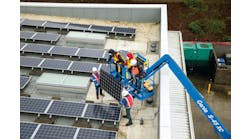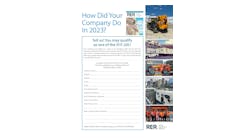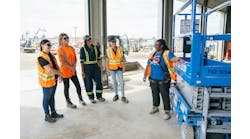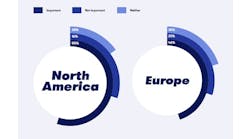Terex Corp. last week posted a net loss from continuing operations for the fourth quarter of 2009 of $114.8 million, or $1.06 per share, compared to a net loss of $452.3 million, or $4.78 per share, for the fourth quarter of 2008. Net sales were $1.058 million in the fourth quarter of 2009, a decrease of 36.1 percent compared with $1.656 million in the fourth quarter of 2008.
Net sales dropped about 41 percent year over year when adjusting for the effect of foreign currency exchange rate changes. Results do not include the Mining and Load King trailer businesses, classified as discontinued operations.
For the full year 2009, Terex reported a net loss of $450.7 million, or $4.39 per share, compared to a net loss of $74 million, or $.74 per share for the full year of 2008. Net sales were $4.04 billion in 2009, a 51.8-percent decrease compared with $8.39 billion in 2008, with foreign currency exchange rate changes accounting for about 3 percent of the decrease in net sales and acquisitions contributing about 2 percent of the increase.
“We just completed one of the most challenging years ever for our industry and our company,” said Ron DeFeo, Terex chairman and CEO. “And while we continue to face very low levels of demand in many of our end markets, the company is beginning to recover operationally, and our strategic transformation has started with the sale of our mining business to Bucyrus International. We had a net sales decline from continuing operations of 52 percent in 2009 compared to 2008. When net sales decline this rapidly, the profitability falls even more quickly, as pricing actions, inventory valuations, bad debt, and restructuring costs all add up. This is why we chose to manage the company for cash in 2009, as well as quickly putting in place cost reduction programs to resize the organization’s cost structure to the current demand environment. We are glad we took this path, even though at times it was painful.”
DeFeo said the company management is, nonetheless, proud of its achievements in 2009. “First, we secured our balance sheet, renegotiated covenants with our bank lending group and increased our liquidity to approximately $1.5 billion through our sales of equity and debt at mid-year. Second, our strategic transformation, which we started with the acquisition of our port equipment business at a fair purchase price and with the financial support of the existing creditors of this business, continues with the sale of our mining business for $1.3 billion. Finally, we realized approximately $538 million in cash from inventory reductions from our continuing operations.”
DeFeo added that he expected Terex’ performance to improve in 2010. “We have begun the process of changing our focus from cash management to growth,” he said. “We see relative stability in our end markets and believe we need to capture market share in order to grow. To do this, we will introduce several new products across a range of our businesses and complete new factories in India and China that will support our business later in 2010 and beyond. We expect to incur operating losses in the first half of 2010, and expect to return to operational profitability in the second half of the year.
“Additionally, we anticipate that our income from operations in the fourth quarter of 2010 will more than offset our interest expense for that period. As the 2010 year develops, we will make choices on the appropriate use of our liquidity, allocating our resources between internal investments, acquisitions and debt payment depending on the relative value and timing of the options being considered.”
Terex has adapted to the recession by producing to end-market demand. “Producing to end-market demand in 2010 will contribute almost $200 million to operating profit improvement,” said Terex president and chief operating officer Tom Riordan. “We do not expect our businesses to show signs of growth until later in the year. We expect that Materials Processing will begin to see improvement first and compact construction will follow, starting in North America. Aerial work platforms will likely remain at current levels for most of the year and pick up in early 2011. Cranes should start to experience moderate growth in the back half of the year, including the port equipment business. We also expect meaningful cost reduction contributions from our supply chain initiatives.”
DeFeo said projecting 2010 performance is still difficult to predict with certainty. “However, we are planning for a flat to slightly improved demand environment in most of our product categories, with the exception of our large crane business where we expect to see some softening in 2010,” he said. “Generally our backlog has stabilized, and our order inquiry rate has picked up. Based on what we see today, our current outlook for net sales in 2010 is approximately $5 billion, an increase of roughly 24 percent from 2009. The translation effect of foreign currency exchange rate changes is expected to contribute approximately one quarter of this improvement, however recent currency exchange rate volatility makes this difficult to predict.”
Terex Corp, a diversified global manufacturer, operates in four business segments: aerial work platforms; construction; cranes; and materials processing. The company is based in Westport, Conn.





